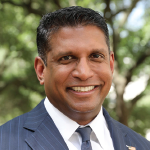For Soham Roy, MD, MMM, who worked as a professional violinist for several years before becoming an otolaryngologist, being able to perform violin on stage with one of his longtime patients was “one of the coolest things I ever did.”
Explore This Issue
February 2010, February 2022Working with children and their families over time and being invited to their celebrations years later is one of the most rewarding parts of being a pediatric otolaryngologist, said Dr. Roy.
“I had a patient—one of my favorite patients still—who was raised by a single mom, and I think he sort of looked to me as an older male mentor,” said Dr. Roy. The patient, who began seeing Dr. Roy at around age 9 or 10, was a violinist, as is Dr. Roy. For the patient’s senior year high school concerto performance, he asked Dr. Roy to join him in performing the two violin parts of Johann Sebastian Bach’s “Concerto for Two Violins,” first and third movements.
“I was blown away—it was emotional,” said Dr. Roy, whose own father died when he was 2 years old. “Being raised without a father myself and being able to do something like that for someone else—I guarantee you, I got much more out of it than he did.”
Musical Beginnings

Soham Roy, MD, MMM
Dr. Roy, 51, holds several professional roles in medicine. He is currently the director of pediatric otolaryngology, a professor and vice chairman for academic affairs, quality and safety, the chief of pediatric otolaryngology–head and neck surgery, the director of undergraduate medical education, and the assistant dean for admissions and student affairs at the McGovern Medical School, University of Texas Health Houston and Children’s Memorial Hermann Hospital. This spring, however, he will join Children’s Hospital/Colorado School of Medicine in Denver as the chief of pediatric otolaryngology.
Long before he began his medical career, Dr. Roy was a musician. As a young child, Dr. Roy first heard his older sister Ina practice the violin. “I fell in love listening to her play the music,” he recalled. “I begged my mom to play.” He began studying classical violin at age 6, accelerated quickly, and ultimately as a teenager went on to play the violin and study music full time.
“I played in opera houses and in chamber music groups as a teen,” he said. “I did it for a few years and it was incredible, but it was a terrible way to make a living,” he said. Dr. Roy recalled living in a 600-square-foot apartment with four other musicians and playing in subway stations to make spare change. “I learned a lot about resilience, but it wasn’t a great way to live,” he said.
His mother told him that he would always love music, but asked, “What will you do on the day that you don’t want to play anymore? You can do something else for a living and can always go play music to cheer yourself up.”
Moving Toward Medicine
With that advice, Dr. Roy returned to a more traditional educational route. He attended Stanford University in Stanford, Calif., graduating in 1991 with a degree in human biology concentrating on medical computer science. Interested in medical informatics, Dr. Roy applied to medical school because an advisor said he “needed an MD to speak the language.” But once he began at the Washington University School of Medicine in St. Louis, Mo., Dr. Roy didn’t keep up with informatics. Instead, he searched for a new path while using music as a pressure release valve.
“Medical school was an angsty time for me, and I did a lot of songwriting then,” he said. “I wasn’t interested in becoming a star; I wrote because it was therapeutic. If I need something to remind me of events during that time, I listen to one of my albums and I remember what was going on when I wrote that song,” he said.
Dr. Roy’s music, which he wrote, recorded, and produced in the mid-1990s, was created on 8-track digital and 4-track cassettes and reflect the pop and new wave songs he grew up with as a 1980s teen. “It wasn’t like I had amazing computer technology to record this stuff like we have now,” he said. “But everything I write, to this day, sounds like that early work.”
Every otolaryngologist I know has a passion outside of work, and doing it makes you a better doctor. —Soham Roy, MD, MMM
In medical school, Dr. Roy gravitated toward otolaryngology. “I saw incredible personalities in otolaryngology—people were wonderfully warm and welcoming. The residents and faculty I met at Washington University during that time were the kinds of people I wanted to spend my life with.”
Working with kids also appealed. “One of the things I love about being a pediatric otolaryngologic surgeon is that a lot of my patients are complex kids who will need intensive long-term care, and it’s a relationship you build over a lifetime. A lot of times, even with short-term patients, you have to build a rapport quickly,” he said.
The Music–Medicine Connection
For Dr. Roy, music’s elements can help develop or strengthen those ties.